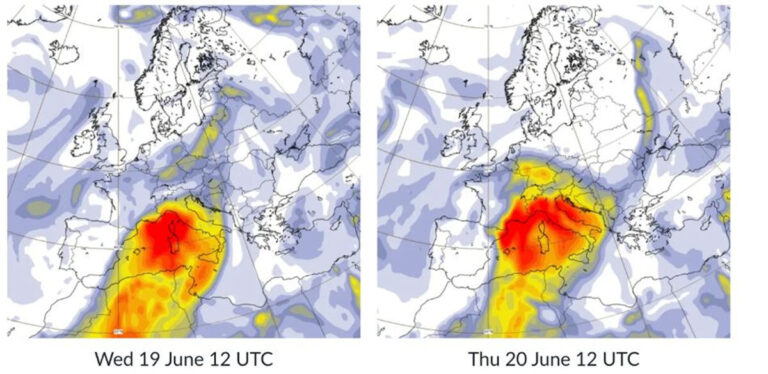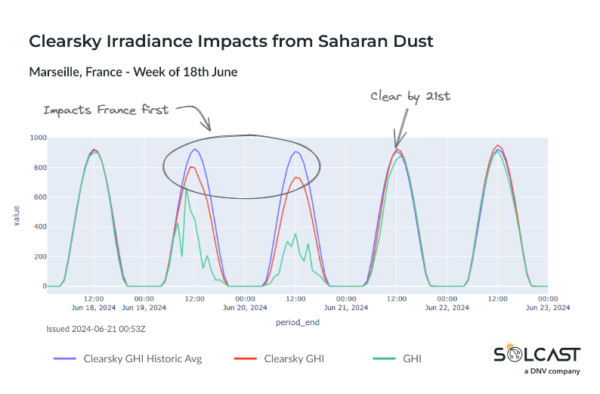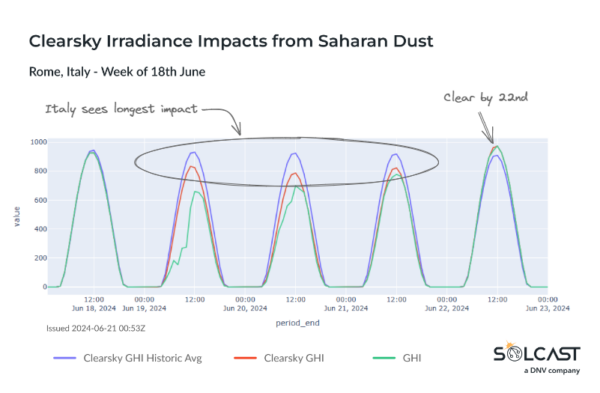In a new weekly update for pv magazineSolcast, a DNV company, reports that a low-pressure system over the Mediterranean has led to significant dust transport, affecting solar generation across Europe throughout the week. Weak low pressure in the Mediterranean brought southerly winds from Saharan Africa across the Mediterranean into Europe, sucking dust into Italy and southern France. High-pressure ridges from the Atlantic Ocean created westerly winds, which pushed the dust around the north of the Alps into southern Germany.
Solar power generation across Europe has been affected by up to 20% this week as dust from the Sahara has been transported through the atmosphere. Dust clouds such as these, which occur relatively frequently, can reduce clear sky radiation – and therefore solar generation – by as much as 20%, although fortunately they only last a few days. This week’s dust cloud is expected to dissipate on Saturday, with areas further north and mountainous areas protected by the Alps seeing reduced impact, according to analysis using the Solcast API.
A low-pressure system over the Mediterranean Sea led to significant dust transport, affecting solar generation across Europe throughout the week. Weak low pressure in the Mediterranean Sea brought southerly winds from Saharan Africa across the Mediterranean Sea
Europe attracts dust to Italy and the south of France. High-pressure ridges from the Atlantic Ocean created westerly winds, which pushed the dust around the north of the Alps into southern Germany. On Saturday the dust will be much less intense, diluted by mixing with the upper part
layers of the atmosphere and spread.
As the dust traveled north, its intensity and resulting impact on irradiance decreased. On Wednesday, June 19, Italy, especially Rome, and southern France, including Marseille, experienced significant impacts. On Thursday, June 20, the dust hit southern Germany, especially Frankfurt and Munich, while Switzerland was largely shielded by the Alps. On Friday, June 21, the dust had cleared from the south of France, but it also had consequences for Berlin. By Saturday, June 22, it had thinned considerably and moved further east.
The impact on clear sky irradiance was notable, with Marseille experiencing a reduction of more than 20% compared to the average Global Horizontal Irradiance (GHI) under clear skies. Saharan dust transports over the Mediterranean are not uncommon in summer as the Azores High migrates north, allowing more low-pressure systems to develop in the Mediterranean. This is why Italy, which extends into the Mediterranean Sea, is generally more exposed to such dust transports.
Solcast produces these figures by tracking clouds and aerosols worldwide at a resolution of 1-2 km, using proprietary satellite data AI/ML algorithms. This data is used to drive irradiance models, allowing Solcast to calculate high-resolution irradiance, with a typical deviation of less than 2%, as well as cloud tracking predictions. This data is used by more than 300 companies that manage more than 150 GW of solar energy worldwide.
The views and opinions expressed in this article are those of the author and do not necessarily reflect those of the author pv magazine.
This content is copyrighted and may not be reused. If you would like to collaborate with us and reuse some of our content, please contact: editors@pv-magazine.com.






